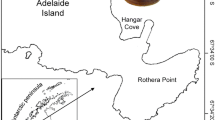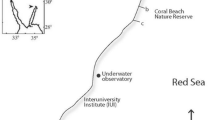Abstract
The reproductive biology of Goniastrea aspera at Magnetic Island was compared with that of a very similar sympatric species, G. favulus as reported by Kojis and Quinn at Heron Island. The development of gametes was similar in both species, but there was no evidence for an adolescent protandrous period of development in G. aspera such as that recorded for G. favulus at Heron Island. Other reproductive differences between the two species were found in egg size and the mode of spawning. The eggs of G. aspera are smaller and more numerous than those of G. favulus. Goniastrea aspera expelled buoyant packets of eggs and sperm, while G. favulus had sticky sinking eggs which were released separately from the sperm. The spatial pattern of the two species was examined on the reef flat at Magnetic Island to determine whether the observed differences in spawning behaviour and egg buoyancy might have an effect on egg retention and the distribution of adult colonies. The results of this comparison failed to detect any difference in the degree of aggregation of the two species. This is not the result which would be expected if sticky sinking eggs helped retain developing larvae in the vicinity of the adult. These results, together with evidence from a wide range of coelenterates and observations on the larvae of G. aspera point to post spawning larval behaviour as the most likely factor in determining where these species will settle.
Similar content being viewed by others
References
Abe N (1937a) Ecological survey of Iwayama Bay, Palao. Palao Trop Biol Stn Stud 2:217–324
Abe N (1937b) Postlarval development of the coral Fungia actiniformis var palawensis Doderlein. Palao Trop Biol Stn Stud 1:73–93
Babcock RC (1980) The biology of Goniastrea aspera in the Townsville region. BSc Hons thesis, James Cook University
Bull GD (1982) Scleractinian coral communities of two inshore high island fringing reefs at Magnetic Island, North Queensland. Mar Ecol Prog Ser 7:267–272
Campbell RD (1974) In: Giese AC, Pearse JS (eds) Reproduction in marine invertebrates, vol 1. Academic Press, New York
Clark PJ, Evans FC (1954) Distance to nearest neighbour as a measure of spatial relationships in populations. Ecology 35:445–453
Collins JD (1978) A study of the interactive biology of corals. PhD thesis, James Cook University
Done TJ (1982) Patterns in the distribution of coral communities across the central Great Barrier Reef. Coral Reefs 1:95–107
Duerden JE (1902) Aggregated colonies in madreporarian corals. Am Nat 36:461–472
Elliot JM (1977) Some methods for the statistical analysis of samples of benthic invertebrates. Fresh Water Biol Ass Sci Publ No 25. Ambleside
Hada Y (1932) A note of the earlier stage of colony formation with the coral, Pocillopora cespitosa Dana. Sci Rep Tohoku Imp Univ Ser 4 7:425–431
Harigan J (1972) The planula larva of Pocillopora damicornis; lunar periodicity of swarming and substratum selection behaviour. PhD thesis, University of Hawaii
Harriott VJ (1983) Reproductive ecology of four scleractinian species at Lizard Island, Great Barrier Reef. Coral Reefs 2:9–18
Harrison P, Babcock R, Bull G, Oliver J, Wallace C, Willis B (1983) Recent developments in the study of sexual reproduction in tropical reef corals. Proceedings of the Inaugural Great Barrier Reef Conference, James Cook University, Townsville
Kojis BL, Quinn NJ (1981) Aspects of sexual reproduction and larval development in the shallow water hermatypic coral Goniastrea australiensis (Edwards and Haime 1857) Bull Marc Sci 31:558–573
Kojis BL, Quinn NJ (1982) Reproductive ecology of two Faviid corals (Coelenterata, Scleractinia). Mar Ecol Prog Ser 8:251–255
Lewis JB (1974) Settlement behaviour of the planulae larvae of the hermatypic coral Favia fragum (Esper). J Exp Mar Biol Ecol 15:167–173
Marshall SM, Stephenson TA (1933) The breeding of reef animals. I. The corals. Sci Rep Gt Barrier Reef Exped 3:219–245
Rinkevich B, Loya Y (1979a) The reproduction of the Red Sea coral Stylophora pistillata. II. Synchronization in breeding and seasonality of planulae shedding. Mar Ecol Prog Ser 1:145–152
Rinkevich B, Loya Y (1979b) The reproduction of the Red Sea coral Stylophora pistillata. I. Gonads and planulae. Mar Ecol Prog Ser 1:133–144
Stearns SC (1976) Life history tactics: a review of the ideas. Q Rev Biol 51:3–47
Stimson JS (1978) Mode and timing of reproduction in some common hermatypic corals of Hawaii and Enewetak. Mar Biol 48:173–184
Szmant-Froelich A, Yevitch P, Pilson MEQ (1980) Gametogenesis and early development of the temperate coral Astrangia danae (Anthozoa, Scleractinia). Biol Bull 158:257–269
Veron JEN, Pichon M, Wijsman-Best M (1977) Scleractinia of Eastern Australia Part II. Families Faviidae, Trachyphylliidae. Aust Inst Mar Sci Monogr Ser 3:1–233
Author information
Authors and Affiliations
Rights and permissions
About this article
Cite this article
Babcock, R.C. Reproduction and distribution of two species of Goniastrea (Scleractinia) from the Great Barrier Reef province. Coral Reefs 2, 187–195 (1984). https://doi.org/10.1007/BF00263572
Received:
Accepted:
Issue Date:
DOI: https://doi.org/10.1007/BF00263572




